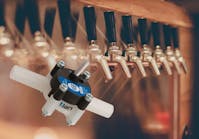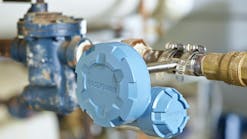What else can condition monitoring sensors tell us?
Remote condition monitoring through sensors or other monitoring tools continues to gain momentum as a best practice to increase equipment uptime. But this approach ignores the ability of sensors to help companies to understand if they are getting the most out of their equipment from the beginning. That is why it is also important to listen to what else sensors can tell us.
Why remote condition monitoring? The traditional answer
Remote condition monitoring helps to address some common questions in industry, such as:
- How do I keep my equipment running so that I don’t experience unplanned downtime?
- How can I make my operations more productive?
- How do I keep my employees safe?
Avoid unplanned downtime
Not knowing the health of your equipment leaves you at risk for untimely equipment failure, which can lead to process interruption, unplanned downtime and lost revenue. Condition monitoring allows you to see when something is out of range for various indicators, including temperature, vibration, oil and performance analysis, so you will know when equipment may need a simple inspection, or be close to failure. If maintenance is scheduled when a potential problem is indicated, the chances of expected downtime are greatly reduced, ensuring that operations stay productive.
Work safely
While equipment safety is important, employee safety is a top priority for most companies. The ability to access equipment condition remotely with wireless sensors, without having to climb a ladder, reach into a tight space or touch potentially hot equipment, makes the environment intrinsically safer for maintenance teams.
Why remote condition monitoring? The ‘other’ answers
While all the above is important, it is what else sensors can tell us that we need to put into practice. Instead of focusing just on the prevention of downtime, companies should look at sensors as knowledge and improvement tools that can streamline what they know about their equipment to improve performance, validate maintenance and purchasing decisions, and give peace of mind when their equipment is on its own.
Condition monitoring practices should be helping companies answer these questions:
- Is equipment working as efficiently and reliably as it should?
- Did we install the new component correctly?
- How can we increase the knowledge and productivity of our teams?
- Did we make the right product/maintenance decision?
Knowing your baseline
Most sensor technology accumulates data in a method — typically a web portal — that allows the user to analyze trends in how equipment behaves in different conditions. This is often only acknowledged when the trend indicates a problem on the equipment that needs to be addressed. However, if viewed in the context that the data is showing how equipment runs in varying conditions and applications, the user can create an equipment profile for a better understanding of normal wear and tear. This information also enables the user to determine when the equipment is running correctly for their application. Basically, the sensor gives a voice to the equipment.
Validate decisions
Having a baseline of data for equipment allows the user to know when it is operating correctly. However, what to fix can still be a series of educated choices from the maintenance team. Once maintenance has been performed, a sensor reading back to baseline validates that the correct choice was made, or that the maintenance was done correctly. In one example, a maintenance team shared that after installing a new component, they instantly received vibration alerts from the sensor. They went back into the machine and discovered that lug nuts had not been properly tightened. The sensor was able to alert them to the error prior to causing damage to equipment (or losing the lug nuts).
In situations where a change in the components for equipment is implemented, a sensor reading back to baseline — especially in equipment that may not have been performing as accurately as expected prior to the change — can validate the purchase.
Looking at these scenarios, where we look at sensor application should also change. If sensor monitoring technology can show baselines that confirm accurate maintenance or installation, then sensors should be implemented when these changes occur, as well as on critical applications to ensure accurate performance.
Streamlining maintenance
Sensors also have the potential to change how maintenance teams schedule routine maintenance and maintain spare parts inventory. Based on sensor data, teams know what truly needs attention each day, rather than relying solely on a prescribed maintenance schedule. This also reduces inventory because the warnings give teams plenty of time to buy needed parts and schedule maintenance without unplanned downtime. Finally, sensors should allow maintenance teams to better manage time and budget.
Peace of mind
It is often said that “machinery is working even when we are not” to indicate that most equipment runs several shifts, if not 24/7. The ability to know if equipment was in trouble, without having to be present, is appealing, but not necessary as a company can have maintenance teams on all shifts. However, the COVID-19 pandemic reminded us that equipment needed to keep running even when it was not safe for people to be there. In this situation, sensors indicated when it was critical for maintenance teams to be onsite for mandatory maintenance but monitoring also allowed those responsible for the equipment to follow baseline information to ensure that operations were running efficiently.
Condition monitoring using sensors and other equipment, designed to proactively alert users to potential problems so that unplanned downtime can be prevented, offer advantages to help users make their operations run more effectively and reliably. We just have to start listening to what else they are telling us.
Vijay Anand, regional product specialist for condition monitoring and diagnostics of motors and generators for ABB, is responsible for providing technical and sales support to North and South American units of ABB. With nearly 25 years of experience in the field of condition monitoring and diagnostics, he has been involved in the development and productizing of tailor-made condition monitoring tools, as well as executing condition monitoring services such as carrying out measurements, performing corrective actions, installations, and commissioning of remote monitoring systems worldwide. Vijay holds a bachelor’s degree in mechanical engineering, and is based in Greenville, South Carolina.

Vijay Anand
Vijay Anand, regional product specialist for condition monitoring and diagnostics of motors and generators for ABB, is responsible for providing technical and sales support to North and South American units of ABB. With nearly 25 years of experience in the field of condition monitoring and diagnostics, he has been involved in the development and productizing of tailor-made condition monitoring tools, as well as executing condition monitoring services such as carrying out measurements, performing corrective actions, installations, and commissioning of remote monitoring systems worldwide. Vijay holds a bachelor’s degree in mechanical engineering, and is based in Greenville, South Carolina.


